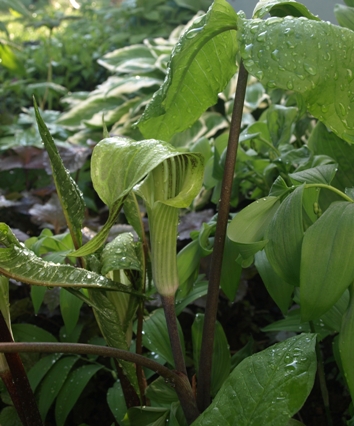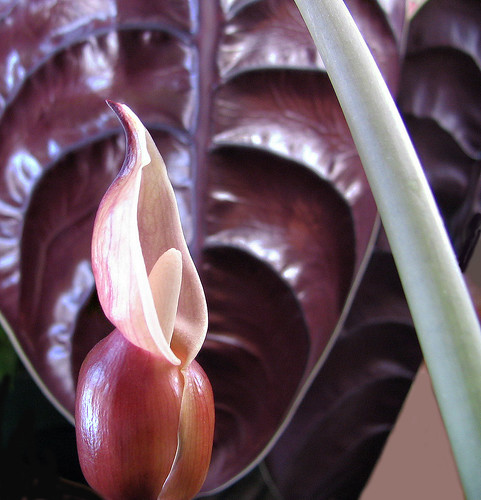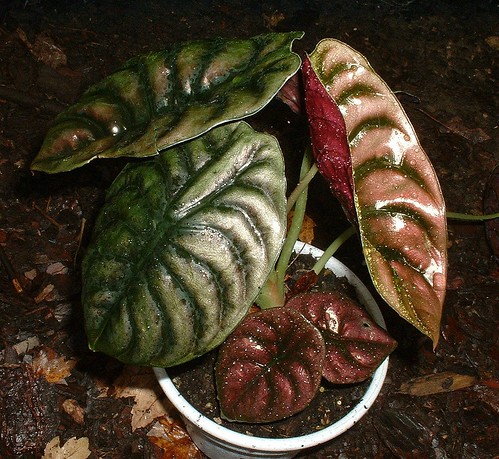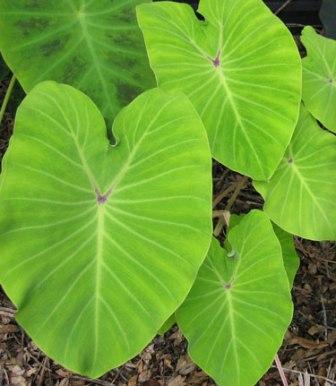First, the bad news. I didn't take these pictures, even if some of these genera have shown up before (golden club, elephant ear), or are lurking suspiciously around the blog (Arisaema sikokianum). Know that I have searched the internet for some of its best photos, and have endeavored to avoid any copywritten pictures.
So
What are aroids? And why should anyone care about them?
Well, for starters, thats one of largest "flowers" on the planet right there. Six feet tall. That means its probably taller than you (shorty). This is Amorphophallus titanium or the Titan arum.
Aroids are the plants that compose the family Araceae. They are flowering monocots known for their spathe and spadix infloresence. If you look at that titan flower, you see basically two parts: the spadix is the purple spike in the middle, and the spathe is the wide purple and green cup-shaped modified leaf (bract) surrounding it. The true flowers (where the magic happens) are actually located on the spadix, although they are so small and boring you can't see them, and wouldn't really want to even if you could. This family contains over 170 genera and 3000 species, and includes some pretty famous ornamental genera that you've never heard of, but have definitely seen or heard of, such as elephant ears, the peace lily, jack-in-the-pulpit, lords and ladies, skunk cabbage, heart of jesus, pretty much every office and mall plant ever, and the root crop, taro. They are found in almost every climate, but are most impressive in the tropics of the New World.

The Peace Lily (Spathiphyllum cochlearispathum)
Aroids are also generally poisonous. Not die-an-agonizing-death poisonous, but any-part-of-you-that-touches-them-gets-irritated due to a fascinating and specialized cellular defense system, where tiny spikes filled with a specific acid are isolated in liquid filled, pressurized vessels, which, when punctured, spew those nasty spikes into whatever caused the damage. They are also pretty acrid. Taro, for example, has to be boiled or dried before you can eat it without getting sick. So I thought I would provide a brief "fundown" of some of the interesting genera out there and the cool things they do. Starting with, of course, Arisaema.
Arisaema
Jack-in-the-pulpit
This genus is characterized by the "pulpit" spathe, where the bract lips over the spadix. The leaves are usually compound with three to five large leaflets. Many are tuberous, and die back to dormancy in the winter or drought. Usually they will only put up one leaf per tuber so if you STEP ON THEM, you're pretty much done for the year. This genus has a wide range, being found both in North America and (with greater diversity) in Asia. They like the shade, and moist soil. Native Jack-in-the-pulpit Arisaema triphyllum
Native Jack-in-the-pulpit Arisaema triphyllum
 Native Jack-in-the-pulpit Arisaema triphyllum
Native Jack-in-the-pulpit Arisaema triphyllum And there are many more, all equally cool.
Arum
Lords and Ladies
Similar to Arisaema this genus likes temperate woodlands, but is found instead in Europe and north Africa. Flowering begins in April, with the production of a pale yellow spathe. The foliage dies back in the summer. In the fall the foliage reappears along with bright red berries. Fair warning, Arum maculatum is pollinated by midges attracted to a "particularly fecal" odor produced by the spadix. Want one that doesn't stink? Arum italicum is a good option.
Arum maculatum
Lysichiton
Arum maculatum
Lysichiton
Skunk cabbage
A swamp aroid found both in North America and Asia. These things create monster root and tuber systems that dwarf the part of them that is above ground. Super roots, like you would need a backhoe to get the ones in the picture below out of the ground kind of super. They are one of the first plants to flower in the spring. If covered in snow, or in danger of freezing, the skunk cabbage is capable of producing its own heat to survive. Its a stinker. There is an Asian species, and it is white.
Lysichiton americanus
Lysichiton americanus
Orontium
Golden Club
One of my new favorites. Orontium is semi-aquatic, and is most often found growing along the edges of lakes or slow moving streams. It lacks a spathe, and doesn't stink. The leaves are waxy and water-repellent and have a nice bluish hue. Graceful thing. 

Whew. Alright. Take a break. Get some water. While those last few genera focused on the spathe and the spadix, this next set will focus on foliage. Aroids exhibit huge diversity as far as cool foliage is concerned. They exhibit a huge variety of shapes, textures, colors, and sizes between the different genera and within populations of the same species. I thought I would focus on the elephant ears because everyone has met at least one of these in their lives and they're cool, even if they're a bit gimmicky. Know that the species here don't even begin to scratch the surface.
Alocasia
These are not from the New World. There are 78 different Alocasia species thus far, and they are found mainly in Asia and Australia. Many of these species produce beautiful infloresences, but remain known ornamentally for their impressive foliage, and because of the unique way new cultivars and populations of interest are created:
Most of these large leafed aroids exhibit genetic instability during both mitosis and meiosis. This means when the cells double their chromosomes with the intent of making an exact copy, the DNA freaks out and throws pieces of itself everywhere. Thus the cells that are created by the splitting of one parent cell into two, or four depending on which process you're looking at, are, more frequently than is normal, different enough from the parent cells to express phenotypic (observable) variation. This instability, combined with the fact that many elephant ear species (especially Colocasia) have been under the steady hands of interested humans for longer than we've been breeding rice, means there are literally thousands of rare and different varieties created through sexual reproduction resulting in seed or by the adoption of "rogue clones."
Meet one of the larger Alocasia, giant taro or Alocasia macrorrhizos
Alocasia 'Frydek' Even though inflorescences are not what this particular genus is all about, they are still difficult to ignore. This is the inforescence of Alocasia cuprea.
Even though inflorescences are not what this particular genus is all about, they are still difficult to ignore. This is the inforescence of Alocasia cuprea.
 Even though inflorescences are not what this particular genus is all about, they are still difficult to ignore. This is the inforescence of Alocasia cuprea.
Even though inflorescences are not what this particular genus is all about, they are still difficult to ignore. This is the inforescence of Alocasia cuprea.
Nice.
Colocasia
This is most famous for being a major staple of the Pacific Islands: Taro. Like less palatable potatoes. Because Colocasia esculenta is the species that is most frequently harvested for its tasty tubers, it remains one of the easiest to get, and one of the oldest as far as human selection is concerned. I have selected a few photos that show the variation present in esculenta and some different Colocasia species as well.
This last picture is kind of blurry but I have included it to make a point: foliage matters (that neon chartreuse guy in the front there is Xanthosoma 'Lime Zinger')
 So. Keep an eye out for aroids. Once you know them, you see them everywhere.
So. Keep an eye out for aroids. Once you know them, you see them everywhere.















Fantastic. Great stuff.
ReplyDeleteBe careful, sounds like you are developing a thing for Aroids.
Tom